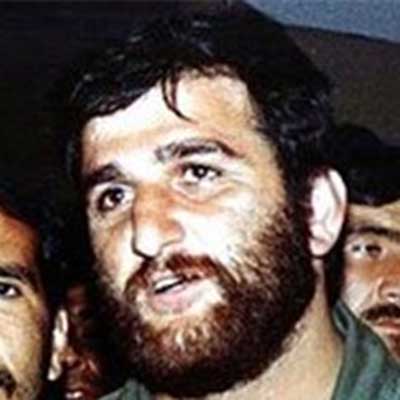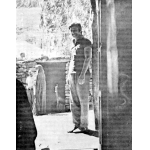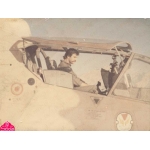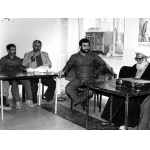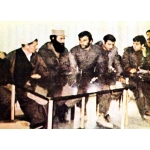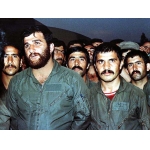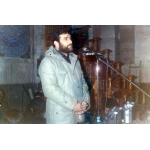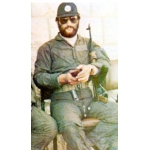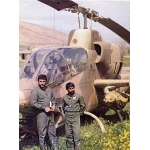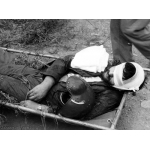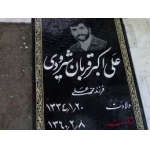Shiroudi, Ali Akbar
Zeinab Ahmadi
534 بازدید
Ali Akbar Qorban Shiroudi, a helicopter pilot in the Islamic Republic of Iran Army Aviation (Havanirooz), was martyred on April 28, 1981, during Operation Bazi Deraz.
Ali Akbar Qorban Shiroudi was born on April 10, 1955, in the village of Balashiroud, Mazandaran Province. Due to his family’s financial difficulties, Shiroudi was unable to complete high school. He moved to Tehran, where he continued his education while working on construction projects. After completing his studies, he joined the Army in 1972. He passed the basic pilot training courses and was then transferred to the Havanirooz garrison in Isfahan for advanced training.
During this time, he learned about the covert deals made by the Pahlavi regime to purchase military weapons from Western countries and decided to share this classified information with revolutionary clerics.[1]
After three years, Shiroudi was sent to the Havanirooz garrison in Bakhtaran, where he met Ahmad Keshvari. In 1977,[2] Shiroudi married Shahnaz Shaterabadi.[3] He had two wives, who gave birth to one child, Anahita, and two children, Adele and Abuzar, respectively.[4]
As the Islamic Revolution approached its victory in 1979, Shiroudi, following Imam Khomeini’s order that military personnel should leave their barracks, left the garrison. He then formed a military committee under the supervision of Hojatoleslam Seyyed Mousa Mousavi, Imam Khomeini’s representative in Kermanshah and Kurdistan, to protect key government buildings in Kermanshah, particularly the radio and television station.[5] After Imam Khomeini returned to Iran on February 1, 1979, Shiroudi played a role in establishing the Bakhtaran Revolutionary Committee. He then joined the IRGC in western Iran and occasionally visited the Havanirooz base to coordinate activities between the Army and IRGC forces.[6]
Shiroudi voluntarily went to Kurdistan Province, where insurgent groups had created tension and chaos, expanding Havanirooz’s role from merely providing aerial support for ground forces to carrying out tasks related to artillery and infantry units. His significant role in defeating insurgents earned him a promotion to senior commander of the helicopter pilots. In early 1979, he participated in clearing garrisons in Sanandaj and Saqqez, which ultimately led to the liberation of the garrisons and the withdrawal of insurgent forces. In late August 1979, when Paveh was under siege, Shiroudi and his comrades, following Imam Khomeini’s order that the conflict in Paveh should end, managed to break the siege with the help of Army and IRGC forces.[7]
On April 8, 1980, Muhammad Boroujerdi, the commander of the IRGC in Kermanshah, wrote a letter to the commander of Havanirooz in Kermanshah, expressing appreciation for Shiroudi’s efforts in defeating the insurgent groups.[8]
Holding the rank of warrant officer at the onset of the Iran-Iraq War on September 22, 1980, Ali Akbar Shiroudi was responsible for managing all flight operations at the Kermanshah Havanirooz base. He flew a Bell 206 helicopter, a light aircraft known as the Jet Ranger, used primarily for reconnaissance, daily. On September 24, 1980, the first fire team led by Shiroudi was deployed to Sarpol-e Zahab to repel the Iraqi army.[9]
On the third day of the war, then-President Abolhassan Banisadr ordered the commander of the Abuzar base in Kermanshah to evacuate immediately. When the commander relayed the order to Shiroudi, he considered it a betrayal and refused to comply. However, most of the troops evacuated the base. After hours of intense combat, Shiroudi and his comrades successfully destroyed an Iraqi armored column (including 48 tanks), forcing them to retreat.[10] As a result, the Iraqi forces occupying Sarpol-e Zahab withdrew on September 27 and moved toward the Gilan-e Gharb axis. Subsequently, Shiroudi and his team attacked the Iraqi division again, destroying about fifty tanks.[11] The Iraqis retreated once more, taking up positions in the northern heights of Sarpol-e Zahab. Continuous attacks launched by the Army Aviation units under Shiroudi’s command forced the Iraqi troops to withdraw again.[12]
In recognition of Shiroudi’s efforts, he was awarded a promotion. However, in a letter to the commander of the Kermanshah base, he rejected the promotion, asking to remain a third warrant officer. To clear his name, Banisadr, who had issued the evacuation order, promoted Shiroudi, but Shiroudi declined the offer. His only wish was to meet Imam Khomeini (RA) and expose Banisadr’s mismanagement and betrayal, as well as certain commanders' negligence.[13]
Due to Banisadr’s poor leadership—specifically not allowing the Army to reclaim occupied areas—Shiroudi repeatedly made public speeches condemning these actions. Consequently, he was sentenced to punitive detention, a decision that was later overturned after the IRGC and clerics raised objections.[14]
On December 30, 1980, Shiroudi embarked on a reconnaissance mission to locate Iraqi positions in key strategic areas such as Qaravis, Bazi Deraz, Gahvareh, and Kure-Moosh. Using two helicopters for support, he launched an attack in those areas, leading to the retreat of the Iraqi army and the capture of 600 Iraqi soldiers.[15]
On January 9, 1981, Operation Meimak was carried out in Ilam Province. The Army Aviation helicopters under the command of Shiroudi and Ahmad Keshvari played a decisive role in its success. This operation resulted in the liberation of several key heights, including Kalleh-Qandi, and peaks 620, 525, and 540.[16]
Under the joint command of the IRGC and the Army, Operation Bazi Deraz was initiated on April 21, 1981, to reclaim heights 1050, 1100, and 1150 in the Bazi Deraz region.[17] Havanirooz deployed 23 helicopters, which significantly contributed to the operation’s success, flying 290 hours in 38 sorties and transporting 946 personnel.[18] Shiroudi served as the operations officer, and according to military personnel from both the Army and the IRGC, the success of the Havanirooz unit largely relied on his leadership capabilities.[19] During this operation, while carrying out reconnaissance and destroying Iraqi forces and tanks, his helicopter was shot down by the enemy, and it crashed, resulting in Shiroudi’s martyrdom on April 28. At the time of his martyrdom, he was a captain. His co-pilot during the operation, Ahmad Reza Arash, was wounded.[20]
After a public funeral at the Abuzar military base and in Kermanshah, Ali Akbar Shiroudi was laid to rest in the martyrs' cemetery in his hometown, Shiroud Tonekabon.[21] When the news of his martyrdom reached Imam Khomeini (RA), he reportedly said, “He is forgiven.”[22] Mustafa Chamran, who was the Minister of Defense at the time, referred to him as “the shining star of the Kurdistan wars.” Describing Shiroudi’s noble personality, Chamran said: “As a member of Havanirooz, he worked with us strafing enemy troops. In fact, Shiroudi defeated the enemy by instilling terror in their hearts. When the Army forces were ambushed and surrounded by the enemy near Saqqez, Shiroudi used courageous tactics to save them.”[23]
Valiollah Fallahi also recognized Shiroudi as the savior of western Iran and the conqueror of the Arbaba Heights, Bazi Deraz, Meimak, Zahab Plain, and the Abuzar base. Hojatoleslam Hashemi Rafsanjani has said, “This country owes Shiroudi a lot.”[24]
In 2003, a memorial was built in Bazi Deraz to honor Ali Akbar Shiroudi.[25] Some military experts consider him the most renowned helicopter pilot in the world.[26]
Shiroudi’s mother passed away on February 22, 2013, and was buried next to her son’s grave.[27]
[1] Unnamed, Parvaz be Arsh-e A'alaa (Flight to the Supreme Throne), Mazandaran: University of Mazandaran Jihad, Undated, pp. 37-41; Shahed Yaran, No. 80, June 2012, pp. 3, 4, and 48.
[2] Parvaz be Arsh-e A'alaa (Flight to the Supreme Throne), p. 60, Shahed Yaran, Ibid; p. 4.
[3] Hosseini, Sayed Majid, Parvaz Ta Binahayat (Flight to Infinity), Tehran: Ketab Hame, 2014, p. 9; Shahed Yaran, ibid., p. 27.
[4] Anahita Shirodi, https://www.jamehnews.com.
[5] Parvaz be Arsh-e A'alaa (Flight to the Supreme Throne), pp. 66-69, Shahed Yaran, Ibid; pp. 4 and 5.
[6] Shahed Yaran, ibid., p. 5 Parvaz be Arsh-e A'alaa (Flight to the Supreme Throne), p. 72; [6] Parvaz be Arsh-e A'alaa (Flight to the Supreme Throne), pp. 66-69, Shahed Yaran, Ibid; pp. 4 and 5.
Tehran: Political Ideological Organization of the Army of the Islamic Republic of Iran, 2010, p. 188.
[7] Parvaz be Arsh-e A'alaa (Flight to the Supreme Throne), pp. 98-102, Shahed Yaran, Ibid; pp. 5 and 6.
[8] Shahmohammadi, Hojjat, Havanirooz dar gharb (Aviation in the West), p. 282.
[9] Ibid., pp. 58-64.
[10] Ibid., pp. 74-72.
[11] Ibid., pp. 100-105.
[12] Ibid., p. 112.
[13] Ibid., p. 285.
[14] Ibid., pp. 163-170.
[15] Parvaz be Arsh-e A'alaa (Flight to the Supreme Throne), pp. 152-162
[16] Razzaqzadeh, Amir, Guide Atlas 3: Ilam at War, Tehran: Islamic Revolutionary Guard Corps, Sacred Defense Document and Research Center, 2002, p. 46.
[17] Shahmohammadi, Hojjat, Havanirooz dar Gharb (Aviation in the West), pp. 141 and 142.
[18] Ibid; p. 148.
[19] Ibid; p. 178.
[20] Ibid; pp. 179-182.
[21] Beheshti, Ali Akbar, Martyr Shiroudi Memorial, Tehran: Islamic Republic of Iran Army, Organization for Preservation of Works and Propagation of Sacred Defense Values, Atashbar, 2015, p. 19.
[22] Samadi, Mohammad Ali, Setaregane Asmane Gomnami (Stars of the Unknown Sky), Tehran: Andisheh Cultural Center, 1999, p. 78.
[23] Martyr Ebrahim Hadi Cultural Group, Bar Faraze Asman ( Above the Sky), Tehran: Aminan, 2013, p. 56.
[24] Shahmohammadi, Hojjat, Havanirooz dar Gharb (Aviation in the West), pp. 199 and 200.
[25] Ahadi, Mohammad, Bande-Ali, Hojjatollah, Monuments of Sacred Defense, Tehran: Martyr Lieutenant General Sayyad Shirazi Educational and Research Center, 2016, p. 119.
[26] Parvaz be Arsh-e A'alaa (Flight to the Supreme Throne), p. 162.
[27] Martyr Ebrahim Hadi Cultural Group, Bar Faraze Asman ( Above the Sky), Tehran: Aminan, p. 192.


